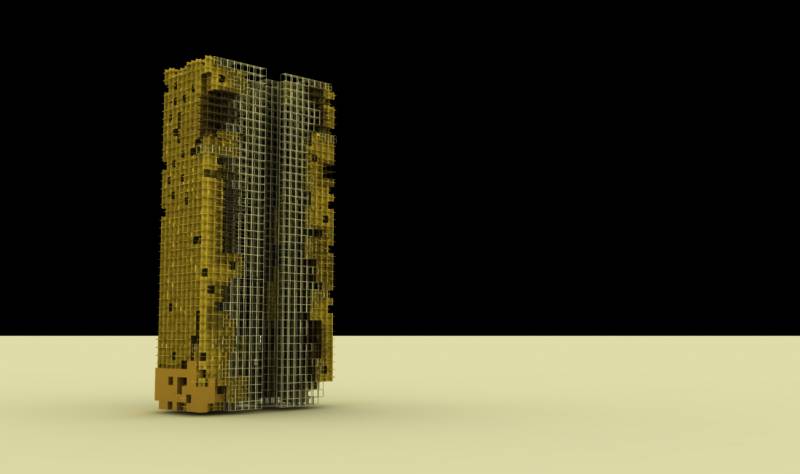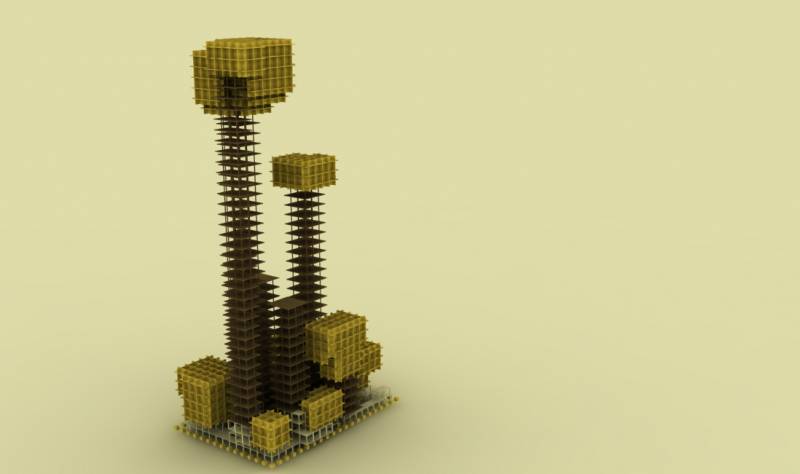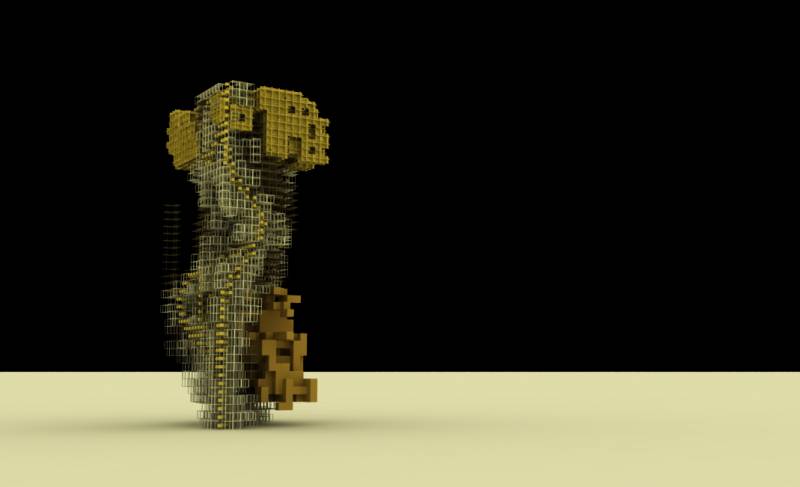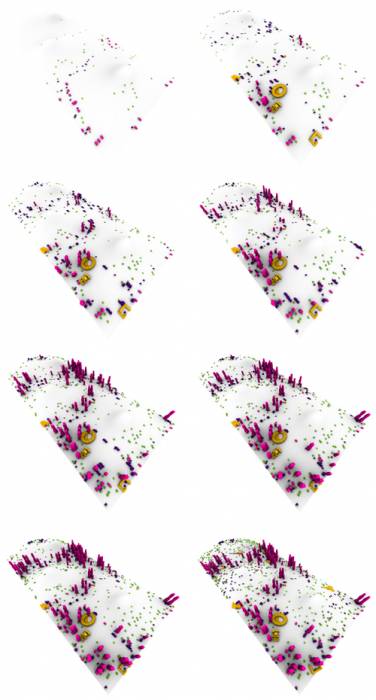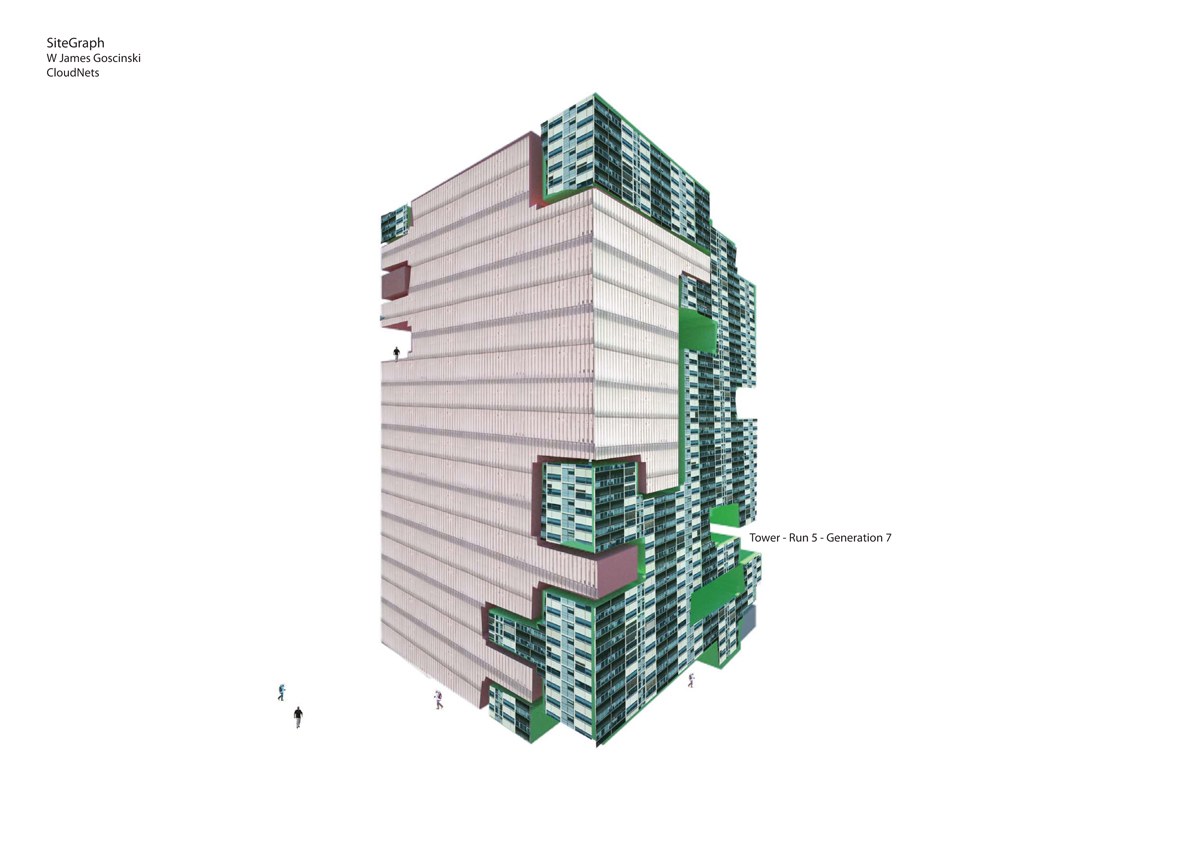Cloudnets aims to develop and demonstrate a software toolset for use by designers. The software allows the designer to explore 3D spaces utilising the graph of relationships and a mechanism for deriving emergent properties used. It has potential applications in city planning, and to landscape, interior spaces and building facades.
Description of research and methodology
A city consists of a number of discrete building in relation to one another. Each building responds in some way to other existing buildings. The type of a specific shop responds to adjacent existing shops. A convenience store wants to be far away from other convenience stores, but a fashion shop wants to be close to other fashion stores. Other attributes (typology, height, colour, material, program etc) similarly have some kind of relationship to other buildings within the city.
A graph is a general way of describing the overall relationships (city) of connectedness in a system of nodes (in this example, buildings). Cellular Automata (CA) are a grid of entities, where the state of each entity responds to the state of adjacent entities. CA have, like cities, properties of emergence – that is the low level rules by which each entity (buildings) decides it’s current states do not describe the higher level phenomena of the overall system (cities).
Cloudnets is a means of making a graph of relationships, and a mechanism for deriving emergent properties based on those relationships, available to CAD software widely used by designers (in this case the Rhino NURB modeler). Scripts operating within Rhino can build and visualise structures controlled by the attributes of each node. So a city can be grown, then regrown with different rules of emergence or starting conditions. Starting with a map of an existing city, new elements can be grown to relate to these existing patterns.
Finally, such systems of relationships and emergent attributes have general application beyond buildings and cities. A landscape, spaces within a building, elements of a facade, or abstract representations of data can be similarly represented.
Cloudnets is a work bench for exploring emergence in general 3 dimensional space. Within the design discourses, emergence is over theorised, with far too few actual designs testing these concepts. Cloudnets intends to address this imbalance.
Scripting techniques give form to these relationships and examine how they could lead to certain patterns within cities. Outcomes are visualised and rendered using the AIR plug-in for Rhino to test architectural and urban implications.
Researcher Bios:
Paul Minifie is an Assoc Professor in the RMIT Architecture program and Director of Minifie Nixon Architects. His work explores the nexus between Architecture and Digital techniques and processes. He is a PhD candidate in Architecture & Design.
Andrew Burrow is an ARC Post Doctoral Research Fellow, and Executive Director of the Spatial Information Architecture Laboratory at RMIT. His PhD (University of Adelaide, Computer Science) concerned information structures and design-space exploration. His current ARC funded research investigates communication in trans-disciplinary design projects, via participatory design of wiki environments, emphasising the act of communication over the exchange of information.
Tim Schork is a sessional staff member and PhD candidate at the Spatial Information Architecture Laboratory at RMIT. His research critically re-considers the relationship between the domains of architecture and computation in order to investigate to what extend the use of computer programming is beneficial to architectural design exploration. Tim is currently a recipient of an Australia Postgraduate Award.
W James Goscinski is a project officer in the Monash E-Research Center and a sessional lecturer in the Faculty of Information Technology, Monash University. His PhD (Monash University, Computer Science) proposed a set of tools to support scientists using high performance computing. He is currently undertaking a Bachelor of Architectural Design at RMIT.
Luke Howson is a contract computer programmer with recent experience developing rhino plugins. He has completed projects for the RMIT University departments of architecture, journalism and social studies. He majored in pure mathematics (BSc), English literature and philosophy (BA) at the University of Melbourne, and his honours thesis examined possible worlds semantics for modal logics.
Communications Elective:
CloudNets 2 – Communications Elective
RMIT Master of Architecture (professional degree), Semester 02, 2008
Elective Leaders: Paul Minifie & Tim Schork with Andrew Burrow and Luke Howson
Project Outline
Cities can appear to us as very real, material objects – we, as architects, tend to observe and manipulate forms, materials and appearances. Although we pay lip-service to the idea of program, very often we take this as given. We have a site, and decide what program it should be, then concentrate on local organisation and form.
An alternative model understands the city as a complex system that can be understood in terms of its distribution of valuable activities that are influenced and made possible by their relationships to one another. These relationships may be effective at a small scale – what is next door – or at a much larger scale, but how are the things that happen in this city different from another city some distance away?
Consider, as a modest example, the difference between convenience stores and motorcycle shops. Convenience stores distribute themselves at equal distance from one another. Motorcycle shops are, by contrast, all next to each other. The difference is explained by the idea of search cost. Someone buying a motorcycle wants to shop around and compare – so a shop will do better business if next to another similar – despite the added competition. On the other hand, no one cares about comparing the price and quality of a litre of milk – so convenience stores are distributed to capture a territory or catchment without competition.
This perspective sees cities as emergent phenomena – that is, simple local rules generate complex global ordered patterns.
This elective investigated these kinds of emergent relational phenomena through the use of various computational techniques to model aspects of these relationships and explored how they can lead to certain patterns within cities.
Students learn the basics of Rhino scripting, some theory of emergent systems, a new perspective on cities, and how to create very rendered and elaborate abstract drawings.
Methods
A ‘graph’ is a formal information structure used to relate things together. A graph lets us answer questions like ‘What do our nearest neighbours do?’ or ‘How far is it to the nearest railway station?’. We can use graphs to make decisions about what something at a particular location may become. ‘Cellular Automata’ are systems that create patterns based on these decisions.
Software
– this elective employed the experimental ‘graphCA’ plugin for Rhino, developed at RMIT, to explore these phenomena.
– various Rhino drawing and learning scripting techniques were used to give form to these relationships.
– the AIR rendering plugin for Rhino was used to produce rendered drawings of these outcomes.
Projects Include:
‘SQUARE WOMBAT,’ All logical solutions with no design prejudice
Student Group: Patrick Eberle, Austrian Exchange student and Scott Crowe, RMIT Architecture student
All logical solutions with no design prejudice.
The objective for this script was to take a programmatic-based analysis of the generation of a city and produce a system for the production of master plans that could respond to both quantitative and qualitative input. There a many variables implemented within to allow for more control over maximum volumes of programs within defined maximum space, quantitative. However, the outcome of program dispersion across the site is largely due to qualitative objectives which designate Public usage. This definition of Public points, either program or circulation, determines the outcome to ensure a qualitative response in a system that produces infinite spatial types based of a process of logical analysis. This was originally designed for the use over the scale of a city, but has been successfully tested within the tower profile.
Institutional requires the user to select a start point and continues from here as a continuous building volume across the site.
Commercial attaches itself to a point Adjacent to the Public for the maximum accessibility to each building.
Office is created as tower structures of either Medium or Small floor plates stacked vertically. They are created Near to Commercial to allow for the servicing of the users of these buildings.
Residential likes to emerge neither near nor adjacent to any other program including itself. However due to its construct as 33 cubic volumes they can become dense complexes.
Car Parking forms below the Commercial or Office if near the ground plane and therefore accessible from the street.
ClearSky is a cleaning up function that ensures that for a set number of points above Public (lane ways) there is a clear zone of Vacancy for light.
PublicPlanes places a ground plane on the lowest Public points if they are stacked vertically above each other.
‘Deliberately CRUDE’
Student Group:
Choon How Gan, RMIT Architecture Student
Nash Sooranna, RMIT Architecture Student
Halley Ong, RMIT Architecture Student
According to the United Nations, over half of the world population will be living in cities by 2010, over 3 billion people. In 1950, by comparison, only 83 cities in the world had a population exceeding one million. This rapid worldwide urbanization, in particular within developing countries, where population growth and migration from rural areas has been significant, was a primary motivator in creating the rules driving our script. The condition of emergence surrounding the relatively rapid materialization of Shanty Towns (Favelas) was of strong interest: the incoming underprivileged masses bounced off the edges of the chock-a-block city or capitalising on those gaps of unwanted land where the affluent refused to build and that the city excluded from its planning. It is estimated that one billion people live in shanty towns, one-sixth of humanity.
The rules were based on proximity of nodes, quality of land (gradient), the economic impact of each archetype onto the next (e.g. the number of houses drive the number of retail within an area, or the number of migrant workers within shanty towns drive the number of factories created) and the radius of influence of each archetype (scale). Our expectation is that the models generated through our rules could potentially be the catalyst to a broader discussion surrounding issues such as gentrification, devaluation, economic inequality, the lack of planning surrounding migration to the metropolis, demand and supply, opportunity, and the distribution of public infrastructure like hospitals and schools. It is important to understand that we were deliberately crude with some rules: we were not aiming for a realistic model, but a simplified and expressive one.
Concerning the inner workings of the engine-script, the first iteration is always a random distribution of mixed archetypes through the city. The remaining iterations follow the rules we have created (which will be described extensively through a series of diagrams in the following pages). The iterations have been documented as well, although we have purposely left the result of each commentary free. We believe it is the role of the observer to draw his/her own observations and conclusions: what kind of city has emerged or disappeared through the successive iterations?
‘Hitogahitoyobu’
Student Group:
Jessica In, RMIT Architecture Student
Charles Peter, RMIT Architecture Student
Hitogahitoyobu describes the Japanese cultural phenomena “people call people”
When a new noodle shop opens, people line up to try out the new product. Sometimes rent-a-crowds are hired. Passers by notice. The customers serve as advertising. If the line stays constant. More customers will come.
This can be applied to different architectural programs that inhabit the city, forming patterns of constant growth and decay. Clusters and dispersment are formed.
This investigation focussed on an area in central Tokyo, Shibuya.
Initially studies were made into the study of programs that typically cluster or don’t cluster together. It was hoped to research possible local level phenomena that form creating a city, and then change the rules that govern these phenomena to emerge into another city. Typically higher topography is of higher value in Tokyo, but Shibuya originally emerged from the crossing of a trade route with a river (the silent attractor) in a valley.
The overlapping of 4 train lines has created a super-node, property with proximity to which currently gains highest pedestrian traffic, and rental yields, outweighing the higher ground. Road networks radiate out from station, forming a centrifugal field. Coffee shops & Video Stores occupy vantage points overlooking plazas, stacking vertically. Bars and Love Hotels occupy dark areas in back-streets and cluster together. Specialty music stores create their own precinct. Restaurants hide themselves behind screens. Convenience Stores are only needed 3 for every block. They reach saturation.
Observations on the Ephemeral
The apparently ephemeral phenomena can usually be traced to logical/ tangible causes.
Around the station, advertising billboards face directly onto the plazas from all angles. On main roads, buildings face the roads. Slopes are conducive to entertainment. Setbacks from main roads, for bars and love hotels. Muddy River banks even when hidden from view, can’t have highrise development.
Different conditions, next to infrastructure, create different values. Roads, rivers, highways and footbridges become attractors and detractors. A road crossing over a river provides different condition to a train line crossing a road. Property law and property value informs how small properties merge together over time. Properties are forced to merge, and new buildings have greater setbacks.
Four major conditions were chosen:
1 Station Sphere of Influence
2 Topography
3 Radial Vector Field that orientates buildings
4 Property Law and Property value
– The 4th condition governs the conditions set out by the first 3.
– Zones result from the overlapping of distance from the station.
– Initial buildings are mapped, and their orientation set towards the station.
The city was then set in motion, working with property laws, and property values as its guide for development. It reconfigures itself reaching up, occupying less ground plane. The city evolves from dense honeycomb, into objects in a fi eld, all facing to a central point. Program is ambiguous, maintaining its stacked and scattered order, stretched vertically. It illustrates the values of today’s society.
COMMUNICATIONS ELECTIVE:
CloudNets 1, Communications Elective
RMIT Master of Architecture (professional degree), Semester 01, 2008
Elective Leaders: Paul Minifie, Ross Heywood, Luke Howson
Communications elective that investigated the emergent properties of running Cellular Automata like algorithms across graphs of arbitrary topology.
‘SiteGraph’
Student:
W James Goscinski
This project investigates the way cellular automata can be used to generate an organisation of program within a building. The purpose of this investigation is to illustrate whether a Cellular Automata model can generate an unexpected organisation of space and form upon a relatively simple set of rules, through a deterministic process.
The first part of this investigation examines a single structure. A 3-dimensional 9 x 5 x 5 graph is used to represent a 9 storey building. Each of the 225 spaces within the graph can be filled with one of three types of program – residential apartments (green), commercial office space (red) and retail shop space (grey) each comprising at least 37%, 37% and 10% of total building space, respectively . In addition, empty space can also be generated.
The program of each ‘cell’ within the building is decided based on: the attributes of its neighbours and their orientation; a set of influencing principles and preferences, such as ‘retail space should be located near the ground’; and rules designed to ensure the model to stays within the defined program space quotas.
The 4 types of spaces are each assigned a variable which is accumulated and de-accumulated as rules are executed. After the rules have been executed, these variables are examined and the cell type is chosen based on the highest variable. To start, the model is seeded with random spaces.
The rules are as follows:
Each cell neighbour (up to 2 hops away) is examined and the type variables are accumulated or de-accumulated based on a directional weight. For example, to investigate a ‘vertical’ organisation of program, vertical neighbours are weighed higher, or alternatively horizontal neighbours are weighed negatively. Neighbours of neighbours are treated differently and are applied different weights.
Influences are applied:
Residential apartments prefer northern aspect and high elevation, while shops prefer to exist close to the ground. Apartments are generated by neighbours of their own kind, but also enjoy empty space around them. Apartments and commercial office space do not like to be near one another and prefer an empty buffer between them.
Weights are adjusted up when any of the three space types drop below their required quota.
The second part of this investigation examines a site with three types of structures, a 15 storey tower, an 8 storey building, and a 4 storey building. The site is graphed as a whole – that is, individual buildings are represented as a regular graph (as in the previous investigation) but all three buildings are triangulated together.
The purpose of this investigation is to see how our previous algorithm performs across multiple inter-related structures.
This set of basic rules produces unexpected effects and complexity. Ribboning, layering, grouping and clustering is visible in the iterations. Types of spaces group together and move apart.
In all experiments, a pattern or order becomes identifiable during the iterations, but unexpected results also become apparent. Some of the iterations stabilise, begin repeating or flip back and forth between opposite states.
‘Sachnaufmwasser’
Group:
Tom Frauenfelder, RMIT Architecture student
Thomas Wirtl, RMIT Architecture student

